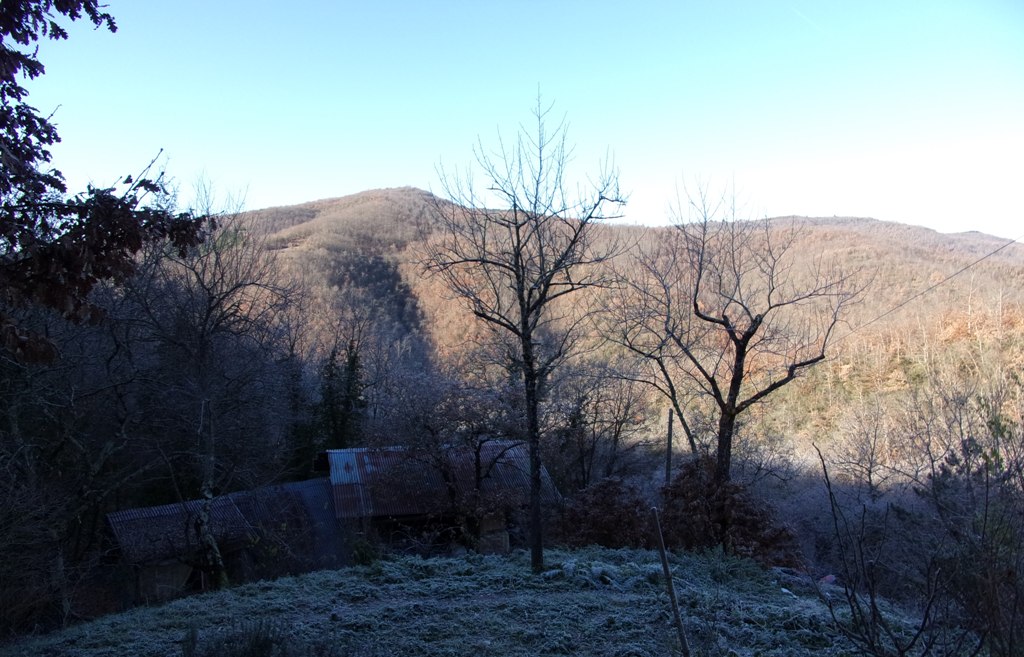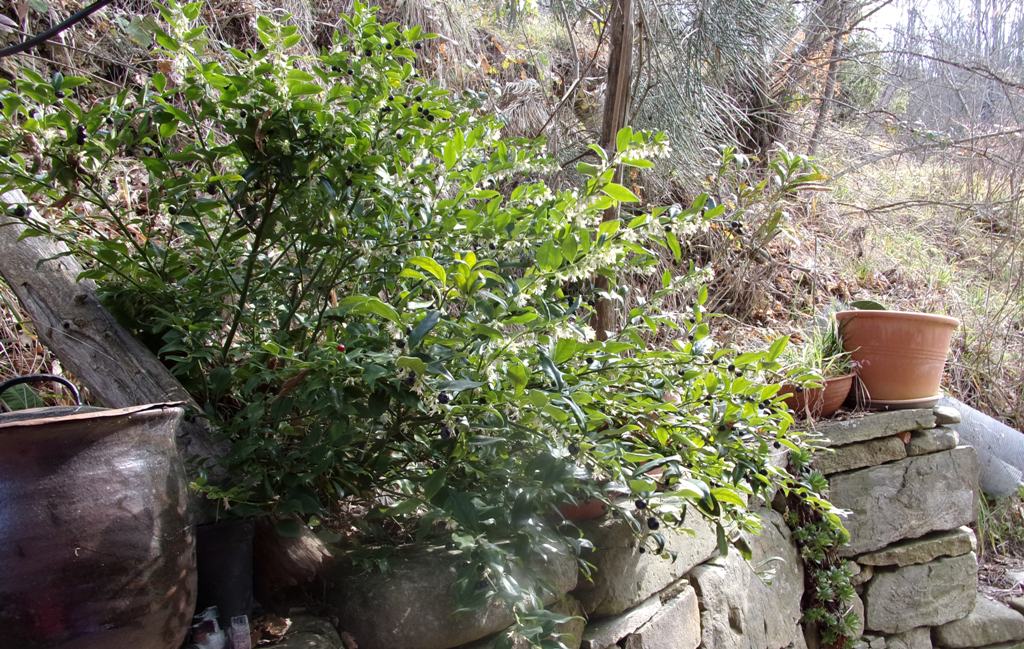This is a report of my time at ‘Marroncello’, a 300 year + farmhouse in Tuscany, Italy:
From Sunday 29th January to Monday 20th February 2023

After spending just a week back in April 2019 with my friend and former classmate, Esther, I decided I would like to spend a bit longer this time.
In 2019 it had just been to get a flavour of what I imagined was a very down to earth and romantic way of living up in the beautiful oak-wood clad hills near Arezzo in Italy.
Before that week I had only been corresponding with Esther since the 1990’s after having both completed a course in Biodynamic Agriculture, back in the Netherlands. I left for Britain and she ended up in Italy!
It all sounded an idealistic way of living to me. Something I’d always envisaged myself doing one day; living in a beautiful place and as much with nature and self-sufficient as possible!
But the Covid virus prevented all the travelling after that first visit in 2019 and only this year I finally managed to get out there again. Late winter was perhaps not the ideal time to travel but with too many responsibilities from spring onwards I decided; it is now or never!
I had been spending 3 weeks with family back in the Netherlands before in January and then took the FlixBus all the way from Amsterdam Sloterdijk to Florence with a bus-change in Verona. It is a trip I am not likely to do ever again as it is extremely long and tiring! I left Amsterdam Sloterdijk at 3pm on Saturday 28th and arrived at Arezzo train station 24 hours later, 3pm, Sunday 29th January.
Esther picked me up opposite the station with her faithful Citroen transport.

My entire stay can be summoned up in short by saying that this is a good, peaceful way of living but not really for the faint hearted and for people who need lots of entertainment or an easy, lazy way of living! Basically it is a very natural way of living with going to bed early and getting up early as well. The days are busy with jobs/ necessary things to do at that moment, but with plenty of breaks and good, honest food, mostly all fresh vegetables from the garden and bread made by Esther. Other items are bought on the local market in Arezzo or brought over from Germany by Thomas, Esther’s partner, who travels frequently between the 2 countries to run his wholesale business in Herbal produce and mixtures.
The house is a typical 300 year + old Tuscan Farmhouse and was found by Thomas nearly 40 years ago in a much dilapidated state. Trees were growing in it!
For a while, whilst he was doing it up, he lived in a small wooden house a bit higher up the hill; this is still being used for temporary accommodation for casual labour and friends/family alike.
The water comes from the stream which runs passed their house and is piped from about 700 metres above by gravity through a thick plastic pipe.
The electricity is through the Solar Panels fixed on the outbuilding of the bathroom/conservatory next to the typical Tuscany type roof with clay tiles. Occasionally a small generator is used to facilitate a washing machine and ironing!

The heating in the kitchen, (2) bedrooms and bathroom (this has a boiler to produce hot water), is by ovens fired with the copious oak wood logs in an around their estate.

There are about 3 hectares (6 acres) of land around the house and up the hill which is being used for crops and fruit trees and also has a stable + yard for their 26 year old stallion called ‘East’. There is a large shed for drying various herbs in the season, a work shed, a polytunnel and various other small sheds for storing hay or other materials. It is a steep hillside so the land has been made more easily accessible by making terraces into it.
The sun does not hit the house and parts of the land until mid-late morning, when it comes round the hill in the east. I was fascinated by the growing ‘sun-line’ on the hills opposite each day in the morning until it was also shining on us at the house!

The hills around are covered in mainly gold-leaved oak, with the occasional evergreen of Italian cypress, Juniper or Pine.
The gold will slowly give way to the vivid green of spring foil I imagine… But that is another time!
The soil is a well-drained, grey/brown, sandy loam with plenty of shale like stone which is the base rock you can see occasionally on the badly worn tracks around. Heavy rain, just before I came, washed a lot of the surface away and made bad gullies, which were more awkward to walk on especially for East!

Many different types of (fruit) trees and crops have been grown during the 40 years Thomas has lived here and about the 25 years that Esther has been there. They aren’t all easily established as the soil has to be improved and maintenance such as watering and weeding is not always easy with so many tasks to do each day and not having enough people and time to do this!
I spent several days of my 3 weeks with weeding and pruning of some of the fruits and ornamentals (such as roses). Weeding of brambles and scrub was done with a pickaxe rather than a hoe on the stony slopes! They were often cut off with a sharp sickle first. It was all new to me; having worked my entire life mainly ‘on the flat’.
All the jobs took so much longer to do! Climbing up and down the hill all day long sapped a lot of energy!
This is why Esther made sure we had 3 good meals a day and several tea breaks! We needed it!!
It is also very much living with the weather:
There were frosts on most nights during my stay and one night it had been severe enough to burst the thick water pipe in the woods so that cut off our water supply! First we had thought that the water had just been frozen in the pipe, but when the water did not come after several days without frosts, we went to investigate and walked about 300 metres into the woods along the pipe. Suddenly Esther saw a water jet through a burst, explaining our lack of water!

It was fixed the following day with another length of pipe and the help of a part-time worker, Rita, who lives in a beautiful mountain village about half an hour away.
The water can also be in short supply during a dry summer. Not just by the fact of no rain but also because the wild boars, which live in the woods, bite trough the pipe, in order to get to the water!
Solar energy is only there when there is enough sunshine!
Wood to heat the stoves is not ‘free’ as some of the casual labour had pointed out to Esther, but has to be cut first and then into logs and smaller sizes to fit the various stoves. In the cold months especially this can be a major task each day.
Also kindling needs to be gathered. A good kindling is made with the dead stems of Spanish/Rush Broom or Spartium junceum, which grows everywhere around on the dryer slopes. Also pine cones and dried peels of tangerines are used as firelighters!

Some flowering bushes in Salagou, Hérault, France (by Michel Chauvet in Wikipedia)
This interesting Broom is also used in other ways I learnt here: https://en.wikipedia.org/wiki/Spartium
Spartium junceum, known as Spanish broom, Rush broom, or Weaver’s broom, is a species of flowering plant in the family Fabaceae and the sole species in the genus Spartium. It is closely related to the other brooms (Cytisus and Genista).
The plant is used as an ornamental plant in gardens and in landscape plantings. It has gained the Royal Horticultural Society‘s Award of Garden Merit.
In Bolivia and Peru, the plant is known as retama, (not to be confused with the genus Retama) and has become very well established in some areas. It is one of the most common ornamental plants, often seen growing along sidewalks in La Paz.
Retama has made its way into the ethnobotany of the indigenous Aymara and Quechua cultures.
The plant is also used as a flavouring, and for its essential oil, known as genet absolute. Its fibers have been used for cloth and it produces a yellow dye.
Then there is the toilet!

This is a fabulous ‘throne’ situated further away and above the house. Made of wood and looking out towards the neighbouring hills it is a bit of a climb to sit, stare and do your business; but it works and is so simple and clean with just a sprinkle, or two, of some brown oak leaves, waiting patiently next to the toilet. ‘It’ all collects in a large bucket, which needs to be emptied when it is full, further along the terrace, near the woods, to break down into harmless organic matter.
Organic waste from the kitchen is also dumped onto a heap on a lower terrace. This can eventually be used to improve the soil for the crops.
So the above is a little description of the workings in this peaceful home of Esther and Thomas.
I decided to lengthen my stay to 3 weeks in order to be a helping hand for Esther as she is mainly trying to manage everything by herself most of the time! Thomas spends a lot of his time in Germany to keep their business going. There are occasional/seasonal workers in the growing season, when needed.
It was a wonderful experience for me to spend these 3 weeks with Esther in these beautiful surroundings. I had been extremely lucky with the weather. Only a few days were overcast but dry and the rest was sunny or slight cloudy. The sky at night also was a sight to behold: Orion, the Moon, Venus and Jupiter were clearly visible most nights! Temperatures were varying to frost at night and early morning and then to spring and early summer temperatures during the day!

Esther having a well-deserved break with ‘Loekie’ the cat!

Some more pictures ….




